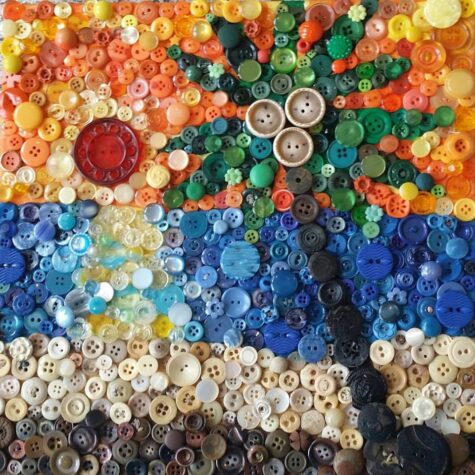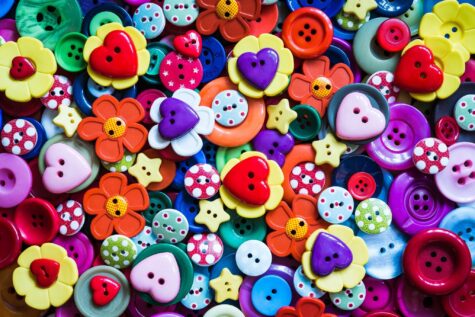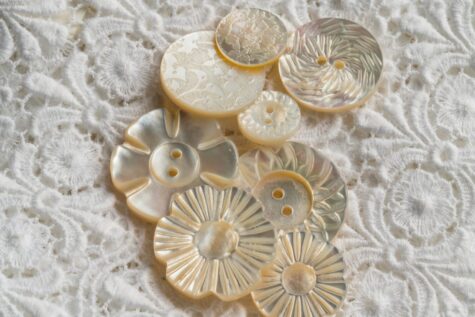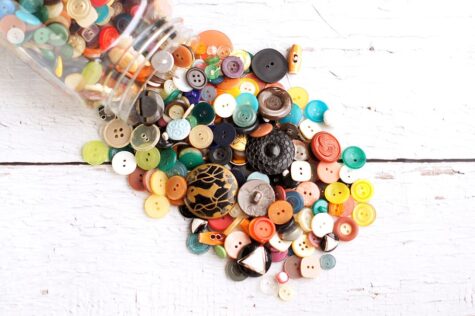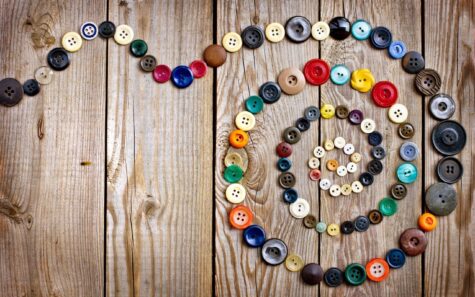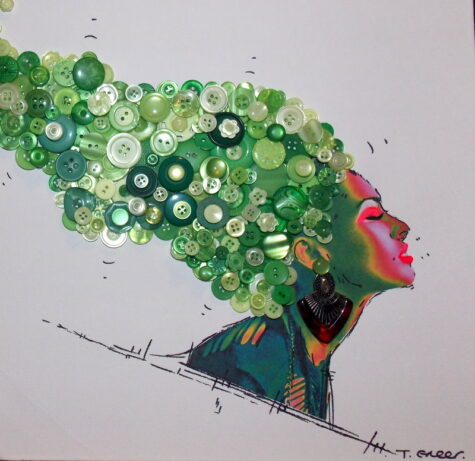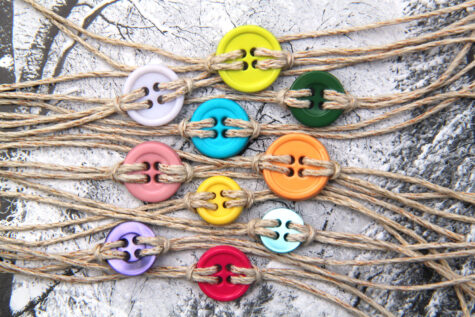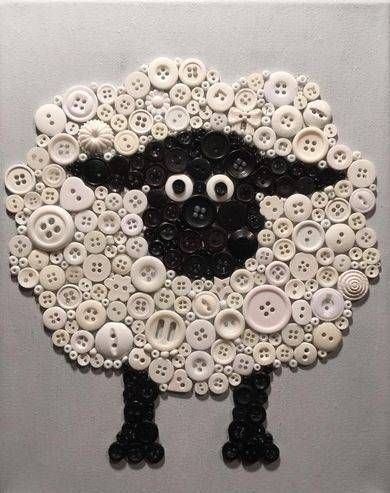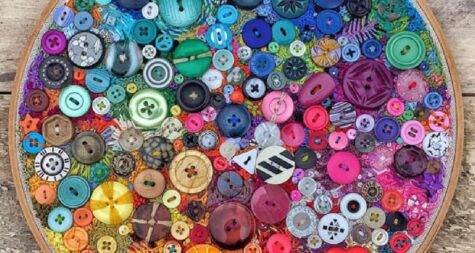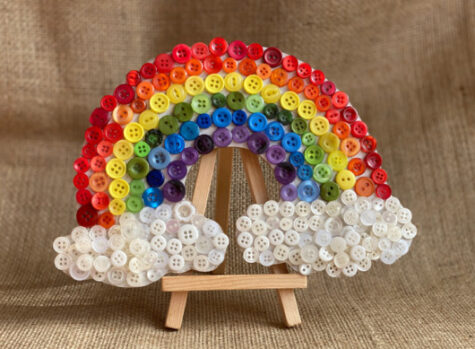Daily Archives: November 16, 2021
National Button Day on November 16th celebrates the function of buttons and the hobby of button collection. Buttons are so commonly found in our clothing that we tend to take them for granted. Buttons have various functions other than just keeping our clothes perfectly together, not denying that it is an important function. They have been used for decorative and gaming purposes as well.
Some people just like to collect buttons for their sparkle and cuteness and others collect signature buttons that have been somehow important to them. There are thousands of button collectors in the United States. Crafters across the country utilize buttons in creative ways. They are some of the best at finding new uses for old items.
Buttons come in different materials, patterns, designs, and sizes. Buttons have been made of a variety of materials. Ancient buttons were formed from natural and readily available substances such as stone, shell, bone, clay, or wood. In more modern times, metals, plastics, resins, and acrylics have been used. While buttons were created to fasten two pieces of cloth together, they also served as decoration.
While buttons today can be simple disks with two or four holes allowing a needle and thread to pass through, button makers create more elaborate designs. If you can imagine it, there’s probably a button like it. From animals and food to iconic buildings and famous people, button makers make them. They’re colorful and fun. While the fun ones may be less practical, they still function.
The origin of buttons can be traced back to 2800 BC where shells were used for making ornaments and seals. However, the buttonholes with buttons as fasteners first emerged in Germany and from there, spread throughout Europe. The buttons were made using the popular materials available during that period. Today, we see buttons mostly made of plastic, metal, wood, or seashells.
Why National Button Day?
The National Button Society was founded after the Hobbies Magazine conducted a hobby show in 1938 and found many participants to be button collectors and thus the National Button Day. Both novice and advanced button collectors celebrate the enjoyment of collecting on this day.
The appeal of buttons is clear. They come in every shape, color and style, from pearly white shirt buttons, to ornate Victorian affairs, to cute fastenings shaped like insects and animals. Any outfit can be updated by adding the right buttons, and sewing them on is one of the easiest types of needlework to learn. And they don’t just belong near buttonholes, either. Clusters of buttons can be used to decorate almost everything, and even on their own in jars they are delightful to handle, play with and admire. Some collect them, but most just lose them. Regardless, nearly everyone seems to love them, or at least regard them with fascination.
In case you may be thinking that buttons do not deserve their own holiday, try to imagine what life would be like without them. Sure, we have zippers and velcro, but could you imagine velcro down the front of your elegant blouse? Of course not!
A Short History of Buttons
It took the buttonhole to popularize the button in medieval Europe. Buttonholes were invented by Moorish tailors as a means of fastening garments and adopted in Europe in the 13th century. Then buttons became so prominent that in some places sumptuary laws were passed putting limits on their use. The earliest evidence comes from 13th-century German sculptures, which show tunics featuring six buttons running from neck to waist.
Buttons in fourteenth century Europe were hand-made in beautiful shapes and colors. They were both costly and decorative and used to boost the ego and attract attention. John Brandon, for example, who died in 1384, was shown with 40 buttons on the sleeve of his undervest alone.
The wearing of gold, silver, and ivory buttons in fourteenth century Europe was an indication of wealth and rank. Expensive buttons were also made of copper and its alloys. The metalsmith frequently embellished such buttons with insets of ivory, tortoiseshell, and jewels.
There was a button mania in the late Middle Ages, resulting, in some outfits adorned with thousands of buttons, all of them with accompanying buttonholes. Dressing and undressing became a laborious process, but created a niche for the employment of professional dressers.
In the 15th or 16th century someone discovered that a loop slipped over a button, or a button pushed through a slit in the cloth, made a better fastener for the close-fitting garments that were coming into style. For some time, however, the chief use continued to be ornamental.
The asymmetrical fastening of jackets of the wrap over style came into fashion in China during the 15th and 16th centuries and was worn by men and women, royalty and peasants. It was the material and the buttons that showed rank. Peasants wore rough cloth fastened with anything that came to hand while the emperor wore silk and furs fastened with jewels.
In the 1700’s metal buttons were used and button covering was created. Metal threads were wound about a button in intricate patterns. Miniature scenes were painted on ivory or glass buttons. Some buttons were engraved and inlaid with silver.
Frederick the Great organised the buttons on soldiers’ coat sleeves being sewed on the top sides of their sleeves. This was to ensure that the soldiers would scratch their faces open every time they tried to wipe their noses on their tunics.
In the middle of the 18th century, Matthew Boulton, the English manufacturer and partner of James Watt, introduced the bright, costly, cut-steel button, which was made by attaching polished steel facets to a steel blank. Matthew Boulton built the Soho manufactory near Birmingham. The factory produced small metal articles such as gilt and silver buttons and buckles.
Noting the abundance of pearl mussels in the nearby Mississippi River, German immigrant J.F. Boepple, founded a pearl button company in 1884 Muscatine, Iowa He produced buttons that looked like pearls by machine-punching them from freshwater mussel shells harvested from the Mississippi River. His button-making factory grew to be the largest manufacturer of pearl buttons in the world. From that time forward, Muscatine was known as “The Pearl Button Capital of the World”.
Celebrating Button Day
Take some time on this day to either go though your existing button collection or start a new one, and enjoy Button Day to the fullest! Who knows, perhaps you possess in your collection an antique button that’s been passed down for so long that you’ve never stopped to think about where it came from. Keep your eyes open! Every now and them someone discovers a treasure that had just been sitting around collecting dust at their home. And even if you don’t, an all you have is regular buttons, don’t worry and just enjoy an afternoon looking at the pretty, shiny little things. At the end of the day, people are animals, and there’s nothing animals like better than something pretty and shiny.
- Take a trip down memory lane.
Do you remember your grandmother or your mother snipping the buttons off shirts headed for the rag basket? Those buttons often collected in jars or tins. Maybe you even played games or strung them for ornaments and crafts. The buttons were fun to stack into piles, sort by color or size, or scatter and slide across the floor or table making up different games each time.
- Begin a button collection.
If you like buttons and didn’t have a chance to collect buttons before, you can observe the day, by collecting your first set of buttons either from your old shirts or get a few nice ones from the store!
- Show your button collection on Social Media
If you have already been collecting Buttons share your collection on Social Media using the following hashtags: #NationalButtonDay and #ButtonDay
- Craft your way with buttons!
If you love designing or making crafts, use buttons to make a unique craft today! You could make anything from greeting cards, posts to toys depending on the colors and size of the buttons! You may look up the internet for other activities too.
- Learn to sew a button!
Another best and productive way to celebrate your love for buttons is by learning to sew on of them. You never know, when this skill might come in handy!
- Play a game with buttons
Play a game with buttons, such as tic tac toe or even checkers. You can also have a contest as to who can build the tallest stack of buttons, or who can flick buttons into paper cups from the farthest distance.
- Visit a buttons museum
Use this day to visit a local museum that displays their button collection! A few museums have an online display too such as the Victoria & Albert Museum, Hammond Turner & Sons, Smithsonian National Museum of the American Indian among many others.
Interesting Facts About Buttons
Men shirts have buttons placed on their right and the women have buttons placed on the left. There is a difference because mostly men dressed themselves using their right hands and the wealthy women were usually dressed with the help of maidens and the left side position of the buttons was necessary for doing it easily. The pattern is still followed today!
- In the ancient days, buttons were used as ornaments rather than as fasteners.
- The oldest ever button is found in Pakistan.
- The Waterbury Button Company has been the largest button manufacturer since 1812.
- New York is home to the largest button in the world.
- Joseph Coors Jr. created the indestructible diamond Z button which obviously must last longer and expensive.
- Before the 13th century, the use of buttons to fasten your clothing was taken as an indication that you led a loose life.
- Francis 1st of France (1494-1547) had 13,600 gold buttons on a single coat, which he wore when meeting King Henry VIII of England.
- King Louis XIV had a coat with 123 diamond buttons on it.
- Today, 60 per cent of the world’s buttons are made in one Chinese town, Qiaotou, which churns out 15 billion buttons a year.
- 1 in 75,000 people suffer from koumpounophobia, the fear of buttons.
- During World War II, Canada gave out buttons to people who tried to enlist but were refused due to medical reasons to show their willingness to fight.
Button Magick
Buttons are incredible little tokens much like coins or rocks that can be used for a plethora of fun and useful witchy crafts. They’re small, portable, wearable, transferable, and can be made easily or found for very little money at most thrift stores and craft shops!
Who knew buttons are magickal little tools? Our ancestors did, of course! Did your grandmother or aunt keep a tin or container of random buttons? Mine did and gifted to me. At the time, I wondered why a tin of buttons was so important. Now I know. If you were blessed with a tin of buttons from your family, keep it and make use of it!
- Ancestral work!
If anyone in your family has sewed they probably have a box/jar/tin of sewing supplies left around with some buttons in it! Use these on ancestral altars to again create that connection.
- Friendship spells!
Buttons are a kind of clasp or connection, therefore using buttons in spells for bonding can symbolize a connection, or clasp, of two or more people!
- A Button Magick Charm Necklace
Back in the day our ancestors collected and saved buttons. If you have a collection of buttons, you can make a magickal button necklace. Or what was once called a wishing necklace. For each button you string onto the necklace, pray over it your intention. Different colors for different intentions, etc. Make it fun and be creative!
- Divination.
Often buttons are used for eyes on dolls and stuffed animals and placing a button in front of you during a divination ritual can help you visualize and therefore open your third eye.
- Elemental Buttons
Buttons of certain materials can be used to harken back to certain elements, like clay or wooden buttons for Earth, or shell buttons for water.
- Altar Decorations
Buttons can be used as altar decorations, and larger buttons can act as tiny plates, display stands, or bases for mini offerings!
- Button Magic With Bags and Bottles
Buttons are great to add to shaker jars. When you shake the jar, they make awesome sounds! For me, part of the allure of a shaker jar is not only the prayer while shaking, but the sensory stimulation. The sounds release energy along with your prayers.
Also, buttons can be added to spell bottles and bags. Again, choose colors and styles matching your intentions. Think of the button’s job in the spell as “buttoning” up the situation.
- Sigils
Draw or paint sigils on the back of buttons with a sharpie and seal with some clear glue/resin. Sew them onto your shirt, bag, or thread them to wear as jewelry!
- A Declaration of Love
Japanese male students often confess their love to a female by giving them the second button from the top of their school uniform. The second button is the one closest to the heart.
Sewing Buttons With Intention
- To attract money – attach the button with the letter Z with a diagonal strip to the other side.
- For many fans – the stitches should be in the form of an hourglass: two horizontal stripes and the letter X in the middle.
- To strengthen friendship – an equal sign;
- Success in creativity – the letter A.
- Success in business – letter Z;
- Harmony with the outside world – a square;
- Gaining developed intuition – two vertical stripes;
- Health promotion – the cross;
- Increase of well-being – a cross and two verticals;
- For gaining passionate love – a cross and a square.
Button Superstitions
Buttons and the superstitions surrounding them are fascinating. While we tend to think very little about these ancient fasteners, our recent ancestors had a lot to say about the magick in buttons.
For example, it is believed that you cannot sew a button “on yourself” so as not to sew up the mind and memory . As an antidote, it is recommended to clamp a thread or other object between your teeth, even a piece of clothing.
Another belief says that sewing buttons on right before the New Year is not the best idea. Better to wait until the next day.
If you are preparing to meet a person who is unpleasant for you, then fasten all your buttons as tightly as possible. The buttons will work like a talisman and protect from any negativity coming your way.
Losing a button from your shoe is bad luck. The only way to get rid of the bad luck is to either spit in your left shoe or spit over your left shoulder.
Most people know that it is bad luck to do up buttons incorrectly. Fortunately, the remedy is easy; all you need to do is undo the buttons, take off the item of clothing, put it on again, and then do up the buttons correctly.
It is good luck to do up an odd number of buttons. If your garment has three buttons, for instance, you can do up either one or all three of them. However, if your garment has two buttons, you should do up the top button only, or leave the garment unbuttoned.
A seventeenth-century rhyme used for counting cherry stones, daisy petals, and other small objects was sometimes recited with buttons. Young women could count the buttons on their clothing to determine whom they would marry.
Tinker, tailor, soldier, sailor,
Rich man, poor man, beggerman, thief.
Like counting flower petals, girls would grab a handful of buttons and count them out to the “He loves me, He loves me not” chant. The last button gives the answer.
Make a wish over a button and throw it into a well. The well fairies like buttons and are said to grant wishes in exchange for a button or two.
- Should you find yourself sewing a button for a bachelor, you will marry him within the year.
- Putting old buttons on a new coat was considered bad luck.
- If a button pops off on a business suit, your luck in business is about to change.
- If three buttons fall off a garment, expect a funeral in the near future.
- A coat with eight buttons brings good luck.
- If someone is spreading lies about you, bite the top button of your shirt and the liar will get a blister on his tongue.
- Gifting buttons is to gift good luck. It brings the receiver good fortune.
The semantic meaning of the word “button” in Russia for many centuries consisted in the verb “scare”. The accessory, in addition to its utilitarian function, played the role of a talisman and served to scare off hostile forces. In the omen about the black cat that crossed the road, to neutralize the negative, you had to take the button and continue on your way. It was believed that this amulet would not allow anything bad to happen.
What does it mean to find a button?
Just because you come across a button, it doesn’t mean that you should pick it up. Everyone must decide for themselves, pick up a button or leave it on the road. A superstitious person will certainly pay attention to the number of holes.
Buttons with one or two holes should be left where they are. Especially destructive is the finding of a button with traces of thread still attached. Popular beliefs warn of imminent misfortunes for the one who appropriated this accessory, because all the illnesses and adversities of the previous owner will go to the one who picked it up.
An important factor will be the color scheme, which suggests that you can pick up only a button with four holes of any color except black.
If found on the street, then this is a good sign. This button portends luck in any undertakings, an easy way to fulfill wishes, the possibility of pleasant changes in life. Sometimes it is interpreted as a prediction of a long journey.
A button found in another busy place is also a good sign: on the verge of a change in life and a high appreciation of professionalism. It was also said that if you find a button while undertaking your daily tasks it is a sign that you’ll make a new friend.
If you find a button on the ground, and decide to pick it up and put it in your pocket, you will have good luck for as many days as the button has holes.
- Green is money.
- White is joy.
- Red is love.
- Blue is success.
- Black is grief.
If you came across a black button in your path, you should NEVER pick it up! It was a sign of bad luck or a curse.
It is especially lucky to find a button with four holes. If you find one, you can count on good news, and if the color of the button is white or green, then in addition to good news, you can expect cash receipts.
Finding buttons also holds different meanings based on which day of the month the button crossed your path.
- A finding in the first seven days of the month means that recognition of the person’s professional merits and his appointment to a new position is soon expected.
- In the second week – it promises good luck in love;
- In the third week – serves as a promise of change in personal life;
- At the end of the month – the possibility of large purchases and unexpected finds.
If a button with two holes is found – you should expect good news related to family or work. Possible unexpected financial receipts or a fundamental change in bachelor status.
On the road lies a talisman with four holes – a series of pleasant events and news awaits a person, and if you sew it in a secret place, the button will work to attract whatever is desired.
If you really want to pick up someone’s loss, pay attention to its color . According to popular beliefs, it predicts joyful or sad events that await in the near future:
If the button is still in the hands, then you can not keep it in your pocket – this will lead to a quarrel between friends or relatives. It is better to sew it on the wrong side of the garment, so that it will be closer to the heart, but invisible to others. Sewn in a special way, it will serve as a talisman, as many centuries ago.
More Things To Do With Buttons
There’s no need to let the buttons on worn-out clothes go to waste! Whenever you can, snip them off, and start a collection.
A great place to come across interesting button is at the thrift shop. You may have to cut them off a given piece of clothing, but when you’re getting something unique for your collection, who really cares?
The buttons you collect can be used for many different things, like repairing clothes with missing buttons. But that’s not all! Buttons are an excellent source of craft ideas. You’d be amazed at how many delightfully cute gadgets can be made and/or decorated using buttons, such as picture frames, clocks, purses and bags, headbands, costume jewelry, lamp shades, and even shoes!
When you decorate with buttons, you can be 100% sure that whatever you make will be completely unique, and that nobody else in the world will have the same look as you do. And if you’re not quite feeling up to arts and crafts, remember that buttons can simply be a joy in and of themselves, if even just to look at. Children can enjoy examining buttons as well, but if you do decide to give your button collection to your child to look at, make sure he or she is old enough to know better than to put them in his or her mouth, because neglecting to do that could result in a tragedy.
Sources:
- National Day Calendar
- Strange Ago
- Timurevts
- Encyclopedia of Superstitions
- National Days Today
- January Witch
- Encyclopedia of Trivia
